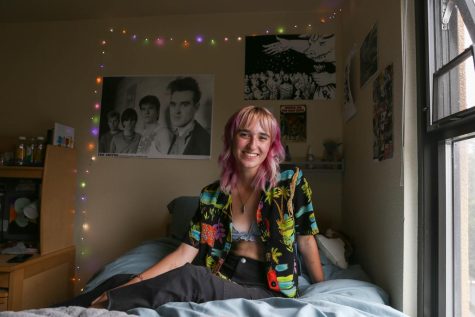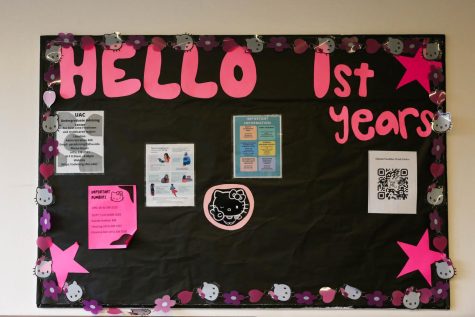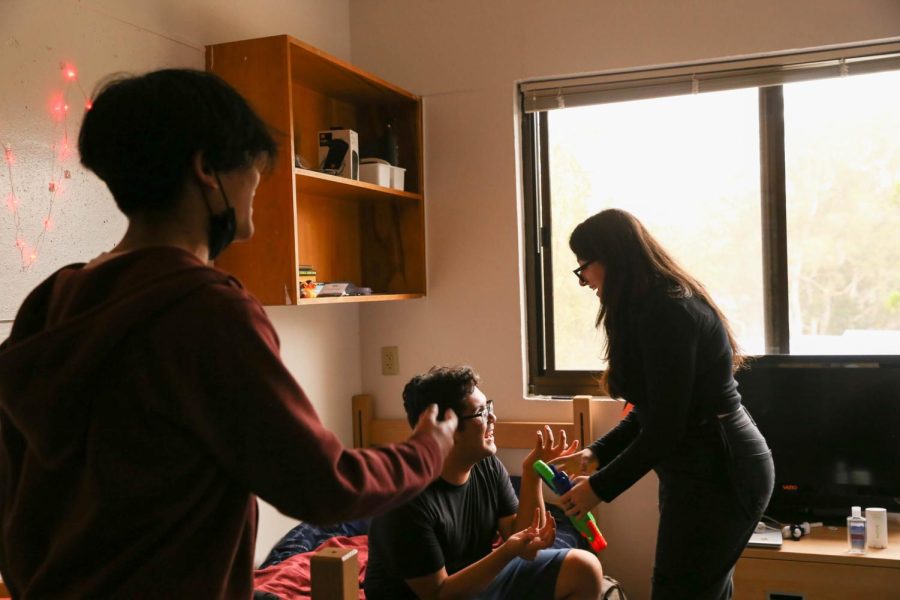New Students on the Block
How first-year SF State students are making the most out of the transition to college life.
First-year student Christian Aransazo (left), Oscar Duran (center) and Elisa Hanhan (right) hang out in Duran’s dorm in Mary Park Hall at SF State on Monday, Sept. 12, 2022. Aransazo and Hanhan both commute, so Duran’s dorm is a place to hang out on campus. (Juliana Yamada/Xpress Magazine)
Fall is in full swing. The air is hot with the last breaths of summer, and students are back on SF State’s soil in the largest numbers since the pandemic. But how are the school’s newest faces handling the change?
Stepping into a new environment can be challenging, no matter the circumstances. Doing so while leaving the security of home for the first time presents a whole slew of challenges and difficulties for anyone. Over 3,000 first-year students enroll in classes at SF State every fall. These students must learn the challenges of navigating campus, parking, making new friends, settling into new routines, accessing the school’s resources and handling classwork all within their first few months. For many, this is a daunting task. Although the university works hard to make transitioning easy and enjoyable, there are always gaps in understanding.
Still, incoming students make the most of their new home every semester.

Sophia Overst, a 17-year-old first-year student from Sacramento, was encouraged by the welcome she received when she visited campus for the first time. Overst originally planned to defer her acceptance to SF State and take a gap year to determine what she really wanted to do with her life. During orientation, however, she fell in love with the university’s environment.
Overst’s eyes started to wander, gesticulating with her hands as she recalled the moment she changed her mind.
“I did orientation just to see what options were available for deferring for a year, and then I was like, ‘Wow, I really love this campus and everyone I’ve met seems really nice, so maybe I’ll just abandon my original plan and go to school.’ So, that’s kind of how I ended up here,” Overst said, as she laughed and pushed her bright pink bangs out of her eyes.
However, Overst has had many unexpected hurdles to jump over since arriving at SF State. Apart from missing her goldendoodle, Gus, and only seeing her family every few weeks, she also struggled with adjusting to dorm life.
Overst resides in a five-person unit in Towers at Centennial Square, yet only has one roommate. As a person who enjoys socializing, she has been disappointed with the lack of community.
“I would love to have more roommates,” Overst explained. “I feel like it would kind of introduce me to more people — just because if we’re all meeting new people, it’s just this giant web of connections.”
The fall semester at SF State has only just begun, but some students already feel pressure to establish their social circle. Without their usual support systems, new students often rely on talking to their fellow classmates about the struggles and excitements of beginning college. Orientation provides an opportunity to do just that, but it doesn’t always work out perfectly — making friends, as it turns out, is not as easy as introducing students to one other.
Among the over 24,000 undergraduate students at SF State, only 2% of them actually live on campus, according to an article from US News about student campus life. So, if assigned to a dorm room with few people, on a quiet floor, in a not-as-social-as-Mary-Ward-Hall dorm like Overst, forming connections can be a bit difficult.
“I’ve only been here for two weeks,” said Overst. “I feel like I have to find friends now, something I’m kind of nervous about — finding a group of people that I’m really close with. Back at home, I had that. So I’m like, ‘what if I don’t have that again?’ But I know it’ll happen. Just be patient.”

Beyond her social sphere, Overst’s can-do attitude makes the logistical portions of living on her own a bit less intimidating. She is more used to buying her own groceries and scheduling her own doctor’s appointments than some of the other students she has met on campus, so she does not spend as much time worrying about how to handle being on her own.
Even considering issues that a student might seek outside assistance with — such as mental health, contraception or STI testing and treatment — Overst feels confident that the university makes accessing those resources easy to find by herself.
“I just knew that they were here,” Overst said about the resources that SF State offers. “In the first week of actual school, all of my teachers have it on their syllabus and tell us where to go if you need those things.”
This is an encouraging similarity between other first-year students at SF State. Many students agreed that even this early on in the semester, they were familiar with the many services SF State provides its students.
Not every student had Overst’s confidence about transitioning into their new home.
Oscar Duran, a first-year student living on campus, has had to make more drastic changes to his daily routine since he moved in.
“For the most part, I’m still trying to learn what floor to be on,” Duran said with a smile.
In high school, Duran relied on his parents for tasks such as waking up in the morning and getting him out the door for school. He would ask for a few more minutes of sleep when his dad came to check in on him, and was rushed through breakfast and getting dressed.
Now, not only does he have to set his own schedule, Duran also has to navigate living with a roommate with an opposite sleep schedule.
“I also have to be mindful of how much noise I’m making because we have inverse schedules,” he said. “I wake up early; he wakes up late. I go to sleep early; he goes to sleep late.”
Duran’s fellow first-year friends live off campus in their hometown of South San Francisco, and have encountered other struggles since classes began.
Evelyn Flores-Ruiz said that since her college career began, she has struggled most with time management. Her friend, Elisa Hanhan, expressed that she does not get as much sleep as she used to because of her longer commute.
Duran, Flores-Ruiz and Hanhan are all originally from South San Francisco and went to high school together. Though only Duran lives on campus, the trio still meets every day to hang out or do homework along with fellow commuter Christian Aransazo before they make their journey home.

“We have to prepare an hour before leaving for school, while people who live here can just get up,” Hanhan said.
Since starting classes, Flores-Ruiz has noticed time with her family dwindling due to her hectic school schedule. The increased commute time means catching her parents before they go to bed has become more infrequent.
“I come home really late, so I still interact with them, but not as much as I did before,” she said.
However, that does not mean that they’re any less involved in her life.
“I would say that my parents are more protective now that I don’t stay home,” Flores-Ruiz said. “They’re like, ‘when are you coming home? Come home at this time.’”
Hanhan, however, recalled how intimidating being alone on campus for the first time felt, describing the experience of having no contact with her parents for an extended period of time as a “huge step.”
Thankfully for students like Hanhan, SF State offers enough guidance on how to make being without family feel less scary.
Karen Boyce, the director of Health Promotion and Wellness at SF State, makes reaching out to students her team’s mission. Their goal is to teach students everything they need to know to stay healthy, especially for those who don’t have much experience taking care of their own needs.
Boyce explained that the department offers programs to help students learn how to cook healthy meals on a small budget, how to handle safe sex, or healthy relationship communication. The department also handles how to navigate sexual violence, stalking, or how get help if someone feels unsafe.
Health Promotion and Wellness is not just about creating pamphlets about birth control and stress-management strategies — it also works to ensure that campus is a safe environment by making the university a cleaner, healthier place for its students and faculty. They take suggestions from students, allowing them to pinpoint gaps in awareness and begin work to fill them.
“We make sure that there’s lots of places on campus where people can get free menstrual supplies, not just here,” Boyce said. “That came from students, and now there’s a law where campuses have to do that.”
Student Health Services also provides medical resources to students. While Health Promotion and Wellness holds mixers and activities for students to learn about health, Student Health Services provides an on-campus pharmacy and doctor’s office, which students can access at any point in the semester for free. Their department also offers STI screening and treatment, HIV prevention, mental health assistance, allergy medication and more.


